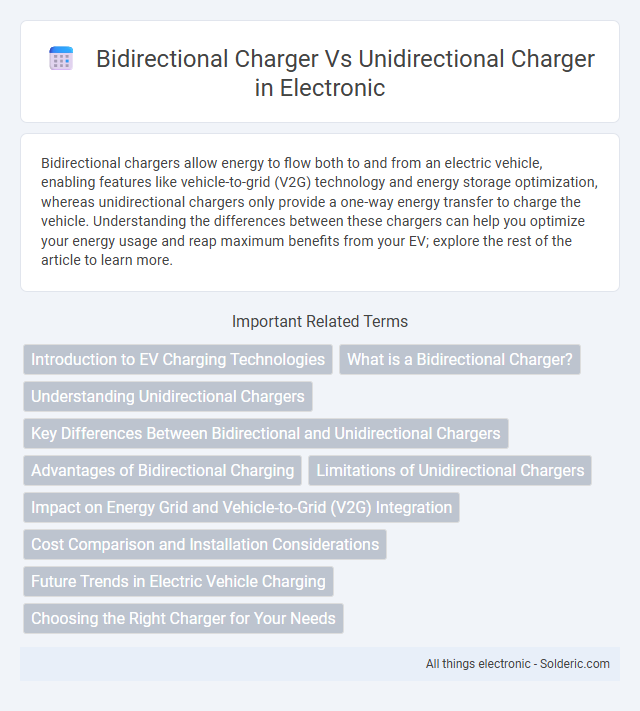Bidirectional chargers allow energy to flow both to and from an electric vehicle, enabling features like vehicle-to-grid (V2G) technology and energy storage optimization, whereas unidirectional chargers only provide a one-way energy transfer to charge the vehicle. Understanding the differences between these chargers can help you optimize your energy usage and reap maximum benefits from your EV; explore the rest of the article to learn more.
Comparison Table
| Feature | Bidirectional Charger | Unidirectional Charger |
|---|---|---|
| Power Flow | Two-way (charging and discharging) | One-way (charging only) |
| Energy Management | Supports vehicle-to-grid (V2G) and vehicle-to-home (V2H) | Supports vehicle charging only |
| Cost | Higher initial investment | Lower initial cost |
| Use Cases | Energy storage, grid support, backup power | Standard EV charging |
| Installation Complexity | More complex, requires advanced infrastructure | Simple installation |
| Compatibility | Compatible with V2G-enabled vehicles | Compatible with all EV models |
| Grid Interaction | Enables grid energy feedback | Draws energy from grid only |
Introduction to EV Charging Technologies
Bidirectional chargers enable electric vehicles (EVs) to both receive energy from and supply energy back to the grid, supporting vehicle-to-grid (V2G) and vehicle-to-home (V2H) applications. Unidirectional chargers solely allow energy flow from the grid to the EV battery, limiting their functionality to standard charging. Emerging bidirectional technology improves grid stability, enhances renewable energy integration, and provides backup power solutions, marking a significant advancement over traditional unidirectional charging systems.
What is a Bidirectional Charger?
A bidirectional charger enables energy flow both to and from electric vehicles, allowing it to charge the battery and also discharge power back to the grid or home. This technology supports vehicle-to-grid (V2G) and vehicle-to-home (V2H) applications, enhancing energy management and grid stability. In contrast, a unidirectional charger only transfers electricity from the grid to the vehicle for charging, lacking energy feedback capabilities.
Understanding Unidirectional Chargers
Unidirectional chargers supply power from the grid to the electric vehicle, enabling efficient battery charging without energy feedback to the grid. These chargers are designed primarily for standard home or public charging stations, ensuring straightforward energy flow with minimal complexity. Understanding unidirectional chargers is key to distinguishing them from bidirectional chargers, which enable vehicle-to-grid energy transfer, offering advanced energy management features.
Key Differences Between Bidirectional and Unidirectional Chargers
Bidirectional chargers enable energy flow both to and from your electric vehicle, allowing vehicle-to-grid (V2G) or vehicle-to-home (V2H) functionality, while unidirectional chargers only allow power to flow from the grid to the vehicle. The key difference lies in energy management capabilities, where bidirectional chargers support energy storage, load balancing, and backup power solutions, enhancing overall efficiency and grid interaction. Your choice between these depends on whether you need reversible charging features for energy optimization or straightforward, single-direction charging.
Advantages of Bidirectional Charging
Bidirectional chargers enable both charging your electric vehicle and discharging power back to your home or grid, providing enhanced energy flexibility and cost savings. This technology supports vehicle-to-home (V2H) and vehicle-to-grid (V2G) applications, allowing you to use your EV battery as a backup power source during outages and to participate in energy markets. Compared to unidirectional chargers, bidirectional chargers maximize the utility of your EV by transforming it into a mobile energy asset.
Limitations of Unidirectional Chargers
Unidirectional chargers only allow electricity to flow from the power source to your electric vehicle, limiting their ability to support vehicle-to-grid (V2G) applications or energy feedback to your home. These chargers restrict energy efficiency and grid resilience by preventing energy storage systems from discharging power back to the grid during peak demand times. Your energy management options are constrained with unidirectional chargers, reducing opportunities for cost savings and sustainable energy use.
Impact on Energy Grid and Vehicle-to-Grid (V2G) Integration
Bidirectional chargers enable energy to flow both to and from your electric vehicle, facilitating Vehicle-to-Grid (V2G) integration by allowing stored energy to support the grid during peak demand. Unidirectional chargers only allow energy to flow into the vehicle, limiting their role in grid stability and renewable energy utilization. Implementing bidirectional charging technology can reduce grid strain, enhance energy resilience, and create new opportunities for grid services and financial incentives.
Cost Comparison and Installation Considerations
Bidirectional chargers generally have higher upfront costs than unidirectional chargers due to advanced technology enabling energy flow both to and from your electric vehicle. The installation of bidirectional systems often requires additional electrical upgrades and may involve complex grid integration, increasing initial expenses compared to the simpler setup of unidirectional chargers. Evaluating your energy needs and future usage plans helps determine whether the long-term savings from energy management with a bidirectional charger justify its higher installation and equipment costs.
Future Trends in Electric Vehicle Charging
Bidirectional chargers are expected to dominate future electric vehicle (EV) charging trends due to their ability to enable vehicle-to-grid (V2G) technology, allowing energy to be fed back into the grid and support grid stabilization. Unidirectional chargers, which only allow energy flow to the EV, face limitations in smart grid integration and energy management applications. Advances in bidirectional inverter efficiency and regulatory support for grid services will accelerate adoption, transforming EVs into dynamic energy resources.
Choosing the Right Charger for Your Needs
A bidirectional charger enables energy flow both to and from your electric vehicle, allowing for vehicle-to-grid (V2G) applications and enhanced energy management, whereas a unidirectional charger only charges the battery. Choosing the right charger depends on your lifestyle, energy goals, and potential to participate in grid services or home energy storage. If you want to maximize energy savings and flexibility, a bidirectional charger offers advanced benefits beyond simple charging.
bidirectional charger vs unidirectional charger Infographic

 solderic.com
solderic.com